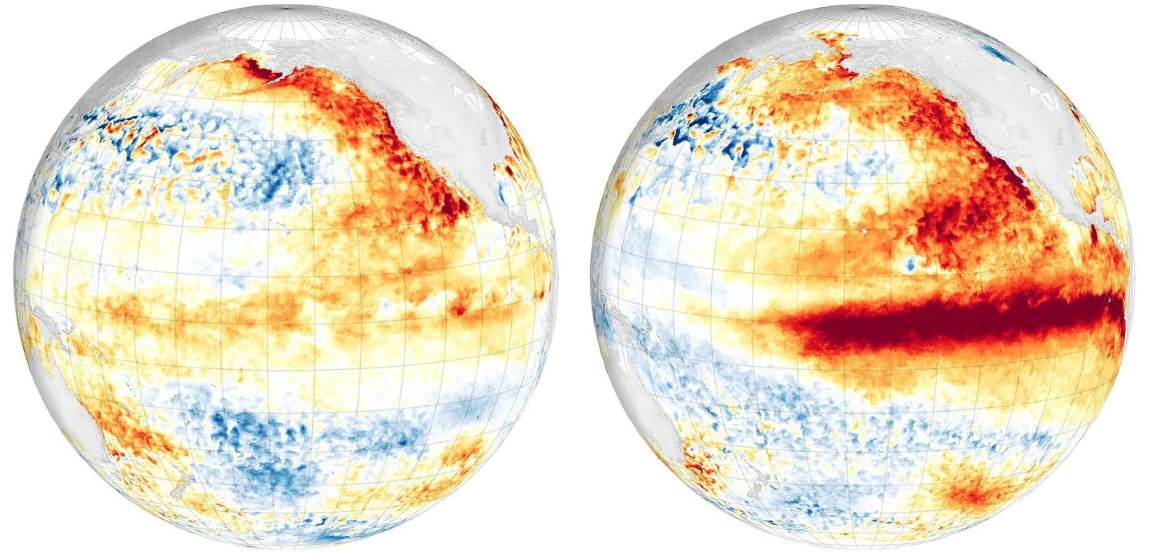A recent study from Duke University researchers reveals that the El Niño phenomenon, a warm ocean event with global climatic impact, has been occurring for at least 250 million years, and its intensity was often greater in Earth’s ancient past.
The findings, published in the Proceedings of the National Academy of Sciences, suggest that the oscillation between El Niño and its cooler counterpart, La Niña, was far more extreme when the continents were positioned differently and global conditions were hotter than they are today.
El Niño, a periodic warming of ocean waters in the eastern Pacific, is known for its ability to alter weather patterns across the globe. It often causes droughts in one region while triggering floods in another. Its counterpart, La Niña, can lead to significant shifts in the jet stream, influencing rainfall and drought patterns. These phenomena have long been a focus of climate researchers due to their ability to disrupt weather patterns on a global scale.
Duke University’s Shineng Hu, a climate dynamics expert and co-author of the study, said that these swings in ocean temperature have occurred for millions of years and were often more severe in the distant past.
“In each experiment, we see active El Niño Southern Oscillation, and it’s almost all stronger than what we have now,” Hu explained.
To better understand the historical extent of this oscillation, Hu and his team ran climate simulations using tools typically employed by the Intergovernmental Panel on Climate Change (IPCC) to model future climate scenarios. Instead of looking forward, however, the team used the model to examine Earth’s climate hundreds of millions of years ago. The simulations focused on 10-million-year intervals, encompassing the Mesozoic period, when the supercontinent Pangea dominated the planet.
Running such extensive simulations was no small feat. The climate model was applied over 26 separate 10-million-year ‘slices’ of Earth’s history, and each simulation ran for thousands of virtual years. These models took months to complete and incorporated a variety of variables, including the different distribution of land masses, solar radiation, and atmospheric CO2 levels.
The results showed that during some periods of Earth’s history, the forces driving El Niño events – such as ocean thermal structure and atmospheric wind patterns – were significantly stronger than today. For instance, at times in the Mesozoic era, the solar radiation reaching Earth was 2% lower than current levels, yet high concentrations of CO2 in the atmosphere resulted in much warmer global temperatures. Despite these differences, El Niño-like oscillations persisted, suggesting that this climatic process is deeply embedded in Earth’s atmospheric and oceanic systems.
Hu noted that previous studies have primarily focused on ocean temperatures, often neglecting the influence of winds on the El Niño phenomenon.
“Besides ocean thermal structure, we need to pay attention to atmospheric noise as well and to understand how those winds are going to change,” Hu said, referring to wind patterns that fluctuate randomly and can amplify or dampen the effects of El Niño. “Atmospheric noise – the winds – can act just like a random kick to this pendulum. We found both factors to be important when we want to understand why the El Niño was way stronger than what we have now.”
The study offers key insights into the conditions that contributed to past El Niño events, helping researchers better predict how the oscillation might behave in the future under ongoing climate change.
“If we want to have a more reliable future projection, we need to understand past climates first,” Hu emphasized.
The oscillation patterns during the Mesozoic were not confined to the Pacific Ocean as it exists today. Back then, much of South America lay at the center of the supercontinent Pangea, and the vast Panthalassic Ocean to the west of it was the primary arena for these temperature swings.
***
The work was supported by the National Natural Science Foundation of China and the Swedish Research Council, with simulations conducted at Peking University’s High-performance Computing Platform.
Journal Reference:
Xiang Li, Shineng Hu, Yongyun Hu, Wenju Cai, Yishuai Jin, Zhengyao Lu, Jiaqi Guo, Jiawenjing Lan, Qifan Lin, Shuai Yuan, Jian Zhang, Qiang Wei, Yonggang Liu, Jun Yang, Ji Nie, ‘Persistently Active El Niño–Southern Oscillation Since the Mesozoic’, Proceedings of the National Academy of Sciences (PNAS) 121, (45) e2404758121 (2024). DOI: 10.1073/pnas.2404758121
Article Source:
Press Release/Material by Duke University
Featured image credit: NASA Earth Observatory maps by Michala Garrison, using data from the MUR SST (Multi-scale Ultra-high Resolution Sea Surface Temperature) project.




